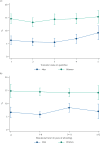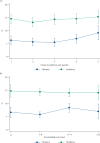Does socioeconomic inequality occur in the multimorbidity among Brazilian adults?
- PMID: 33331530
- PMCID: PMC7703529
- DOI: 10.11606/s1518-8787.2020054002569
Does socioeconomic inequality occur in the multimorbidity among Brazilian adults?
Abstract
Objective: To assess the prevalence of multimorbidity among Brazilian adults and its association with socioeconomic indicators.
Methods: Cross-sectional study that used data from the Pesquisa Nacional Sobre Acesso, Utilização e Promoção do Uso Racional de Medicamentos no Brasil (PNAUM - Brazilian National Survey on Access, Use and Promotion of Rational Use of Medicines), carried out between 2013 and 2014. The definition of multimorbidity was the coexistence, in a single individual, of two or more chronic diseases, measured through a list of 14 morbidities (self-reported medical diagnosis throughout life). Economic status and educational level were the socioeconomic indicators used, being the inequalities assessed through the Slope Index of Inequality (SII) and the Concentration Index, stratified by gender.
Results: The study comprehended 23,329 adults (52.8% of which were women), with an average age of 37.9 years. Hypertension and high cholesterol levels were the most prevalent conditions. The prevalence of multimorbidity was of 10.9% (95%CI 10.1-11.7) representing nearly 11 million individuals in Brazil, of which 14.5% (95%CI 13.5-15.4) were women and 6.8% (95%CI 5.9-7.8) were men. The occurrence of multimorbidity was similar according to the socioeconomic indicators. In the inequality analysis, we observed absolute and relative differences in men with a higher purchasing power (SII = 3.7; 95%CI 0.3-7.0) and higher educational level (CIX = 7.1; 95%CI 0.9-14.7), respectively.
Conclusions: The frequency of comorbidities in Brazilian adults is high, especially in absolute terms. We only observed socioeconomic inequalities in multimorbidities among men.
OBJETIVO:: Avaliar a prevalência de multimorbidade e a associação desta com indicadores socioeconômicos entre adultos brasileiros.
MÉTODOS:: Estudo transversal que utilizou dados oriundos da Pesquisa Nacional sobre Acesso, Utilização e Promoção do Uso Racional de Medicamentos no Brasil, realizada entre 2013 e 2014. Multimorbidade foi definida como a coexistência, no mesmo indivíduo, de duas ou mais doenças crônicas, e é mensurada a partir de uma lista de 14 morbidades (autorrelato de diagnóstico médico na vida). Classe econômica e escolaridade foram os indicadores socioeconômicos utilizados, sendo as desigualdades avaliadas pelo Slope Index of Inequality (SII) e pelo Concentration Index (CIX), estratificadas por sexo.
RESULTADOS:: O estudo considerou 23.329 mil adultos (52,8% de mulheres), com média de idade de 37,9 anos. Hipertensão e colesterol alto foram as condições mais prevalentes. A prevalência de multimorbidade foi de 10,9% (IC95% 10,1–11,7), representando, aproximadamente, 11 milhões de indivíduos no Brasil, sendo 14,5% (IC95% 13,5–15,4) entre mulheres e 6,8% (IC95% 5,9–7,8) entre homens. A ocorrência de multimorbidade foi similar segundo os indicadores socioeconômicos. Nas análises de desigualdade, observou-se diferença absoluta e relativa para homens com maior poder aquisitivo (SII = 3,7; IC95% 0,3–7,0) e maior escolaridade (CIX = 7,1; IC95% 0,9–14,7), respectivamente.
CONCLUSÕES:: A frequência de adultos brasileiros com multimorbidade é alta, principalmente em termos absolutos. Desigualdades socioeconômicas na multimorbidade foram observadas somente entre homens.
Conflict of interest statement
The authors declare no conflict of interest.
Figures




References
-
- Mercer S, Furler J, Moffat K, Fischbacher-Smith D, Sanci LA. Multimorbidity: technical series on safer primary care. Genebra: World Health Organization; 2016.
- 1. Mercer S, Furler J, Moffat K, Fischbacher-Smith D, Sanci LA. Multimorbidity: technical series on safer primary care. Genebra: World Health Organization; 2016.
-
- Puth M-T, Weckbecker K, Schmid M, Münster E. Prevalence of multimorbidity in Germany: impact of age and educational level in a cross-sectional study on 19,294 adults. BMC Public Health. 2017;17(1):826–826. doi: 10.1186/s12889-017-4833-3. - DOI - PMC - PubMed
- 2. Puth M-T, Weckbecker K, Schmid M, Münster E. Prevalence of multimorbidity in Germany: impact of age and educational level in a cross-sectional study on 19,294 adults. BMC Public Health. 2017;17(1):826. 10.1186/s12889-017-4833-3. - DOI - PMC - PubMed
-
- Prazeres F, Santiago L. Prevalence of multimorbidity in the adult population attending primary care in Portugal: a cross-sectional study. BMJ Open. 2015;5(9):e009287. doi: 10.1136/bmjopen-2015-009287. - DOI - PMC - PubMed
- 3. Prazeres F, Santiago L. Prevalence of multimorbidity in the adult population attending primary care in Portugal: a cross-sectional study. BMJ Open. 2015;5(9):e009287. 10.1136/bmjopen-2015-009287. - DOI - PMC - PubMed
-
- Nunes BP, Chiavegatto ADP, Filho, Pati S. Cruz Teixeira DS, Flores TR, Camargo-Figuera FA, et al. Contextual and individual inequalities of multimorbidity in Brazilian adults: a cross-sectional national-based study. BMJ Open. 2017;7(6):e015885. doi: 10.1136/bmjopen-2017-015885. - DOI - PMC - PubMed
- 4. Nunes BP, Chiavegatto Filho ADP, Pati S, Cruz Teixeira DS, Flores TR, Camargo-Figuera FA, et al. Contextual and individual inequalities of multimorbidity in Brazilian adults: a cross-sectional national-based study. BMJ Open. 2017;7(6):e015885. 10.1136/bmjopen-2017-015885. - DOI - PMC - PubMed
-
- Nunes BP, Camargo-Figuera FA, Guttier M, Oliveira PD de, Munhoz TN, Matijasevich A, et al. Multimorbidity in adults from a southern Brazilian city: occurrence and patterns. Int J Public Health. 2016;61(9):1013–1020. doi: 10.1007/s00038-016-0819-7. - DOI - PubMed
- 5. Nunes BP, Camargo-Figuera FA, Guttier M, de Oliveira PD, Munhoz TN, Matijasevich A, et al. Multimorbidity in adults from a southern Brazilian city: occurrence and patterns. Int J Public Health. 2016;61(9):1013-20. 10.1007/s00038-016-0819-7. - DOI - PubMed
MeSH terms
Substances
LinkOut - more resources
Full Text Sources
Medical

